
Facebook PPC advertising can help businesses increase sales and boost brand recognition. However, running an effective campaign isn’t easy—costs fluctuate, and ads often lose effectiveness over time. Achieving a positive return on investment (ROI) can be challenging.
The past year has been especially difficult. Economic changes triggered by COVID-19 forced businesses to quickly adapt to new conditions. Despite these challenges, leading digital marketers have discovered innovative solutions to drive success.
In this article, we will explore some of the most effective Facebook advertising strategies that we use at PPC Geniusto launch profitable ad campaigns for our clients.
Choose the Most Profitable Customer Avatars
Most businesses have multiple customer avatars that they target with their products or services. Narrowing down to the most profitable ones is an effective way to maximize Return on Ad Spend (ROAS).
Consider a protein powder brand with the following customer avatars:
People starting their fitness journey.
Those looking to lose weight.
Dedicated weightlifters who have been training for years.
The brand may struggle to achieve a positive ROAS when targeting the first two avatars, as they may have a lower lifetime value (LTV). These consumers might lose motivation and stop purchasing the product after an initial burst of enthusiasm.
However, the third consumer profile could be highly profitable, as weightlifters consistently purchase protein powder for years.
Of course, this is just an example. A company might find that the initial enthusiasm of the first two groups leads to higher average order values (AOV), making them highly profitable in a different way.
For a deeper dive into this marketing strategy, check out Episode 283 of the Perpetual Traffic Podcast.
Always Challenge Your Assumptions
Always question your assumptions about who is buying your product. This is especially important if you created your customer avatars a long time ago and haven’t updated them. You need to ensure that the people you’re targeting with your ads are the ones actually purchasing your product.
Going back to the protein powder brand example, the company might analyze its data and discover that dedicated weightlifters who have been training for years aren’t buying their product due to loyalty to an existing brand.
As a result, they might decide to stop targeting this group or adjust their strategy to highlight their product’s advantages over competing protein powder brands.
Effective Facebook PPC Strategies Are Constantly Evolving
We’ve all seen online ads promoting miracle investments or highly profitable work-from-home strategies.

It’s designed to feel like an incredible opportunity that you can’t resist. Who wouldn’t want to turn a small investment into a second income, just like in the ad above?
But no one believes these ads anymore because we’ve all seen them before.
The same thing can happen to your Facebook ads. Over time, they lose effectiveness as your target audience becomes less responsive to the tactics you’re using.
For example:
A declining click-through rate (CTR) may indicate that people are no longer engaging with your ads.
A drop in conversion rate may suggest that your audience no longer finds the offer compelling.
You Don’t Have to Start from Scratch
When an ad stops performing, it’s tempting to start over completely. However, creating a brand-new ad isn’t always necessary. Adjusting your messaging or campaign structure can have a significant impact.
For example, the ad below from Diggity Marketing encourages people to download an SEO case study that can help increase website traffic. This is an attractive offer for the ad’s target audience—website owners.

Why Ads Stop Performing & How to Refresh Them
There are many reasons why an ad might stop working—people may see it too often and lose interest, or competitors may introduce a similar offer.
The good news is that Diggity Marketing has several options to revamp its Facebook ad campaign without starting from scratch:
Keep the case study offer but adjust the messaging—for example, adding specific revenue figures or turning it into a “How-To” guide.
Swap the case study for another existing offer. If the company has already invested in content marketing, they can use resources from their content library.
Repackage the same information into a recorded webinar or a free online course. This small change might appeal to users who prefer video-based learning.
The third option is exactly what Diggity Marketing did. The new ad shifts the offer from downloadable case studies to free training that helps users build affiliate websites. The training likely contains the same insights as the original guides but is presented in a different format.
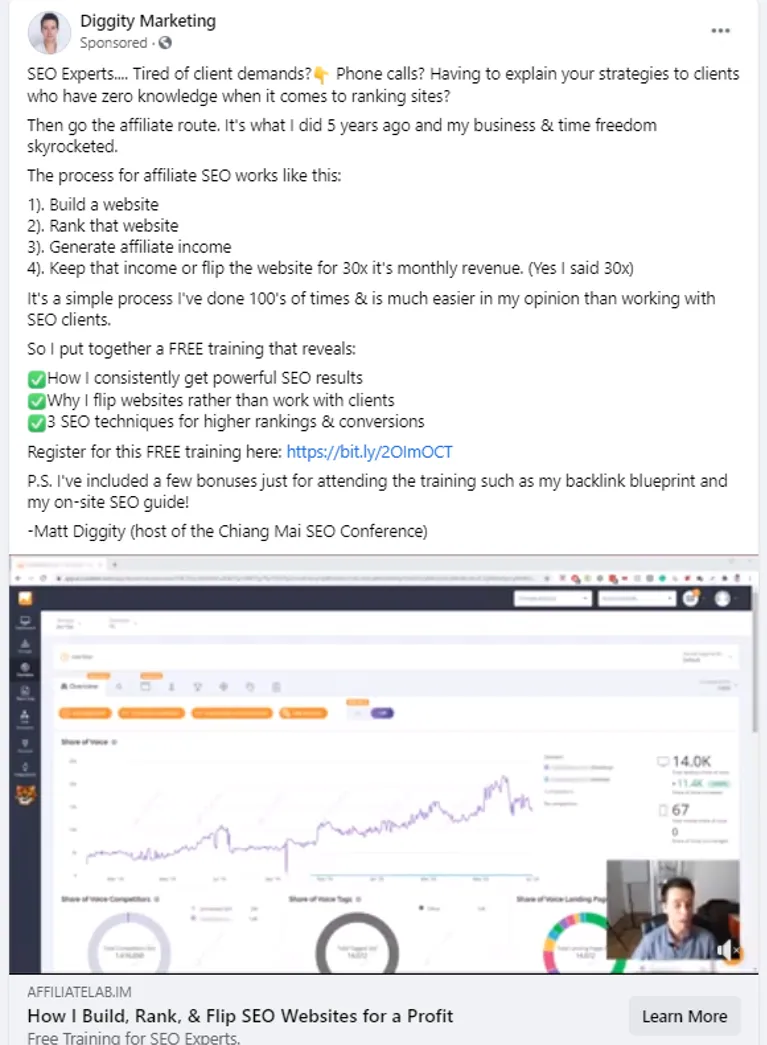
Show Facebook Ads to Customers at the Right Time
The timing of your Facebook ads can significantly impact their success. You need to deliver the right ad at the right time.
First, consider when your target audience is online. If you already have data on this, you can schedule your campaign to run only during those hours. If you’re new to Facebook advertising, you’ll need to gather data first.
At PPC Genius, we prefer to run ads 24/7 at the start, then gradually scale down to focus on the most effective time slots.
Timing Matters in Different Campaign Stages
Facebook provides various ad scheduling options, allowing you to target users based on their past interactions with your content.
Businesses with short sales cycles can target customers who visited their website within the last 15–30 days.
B2B brands aiming for brand awareness may opt for longer time frames.
At PPC Genius, we also run link-building campaigns for website owners through our partner agency, Linkbuilder. We typically:
Retarget users on Facebook soon after they visit a relevant page on our website, continuing for 10 days.
After 45 days, we show them another retargeting ad to reinforce brand recall.
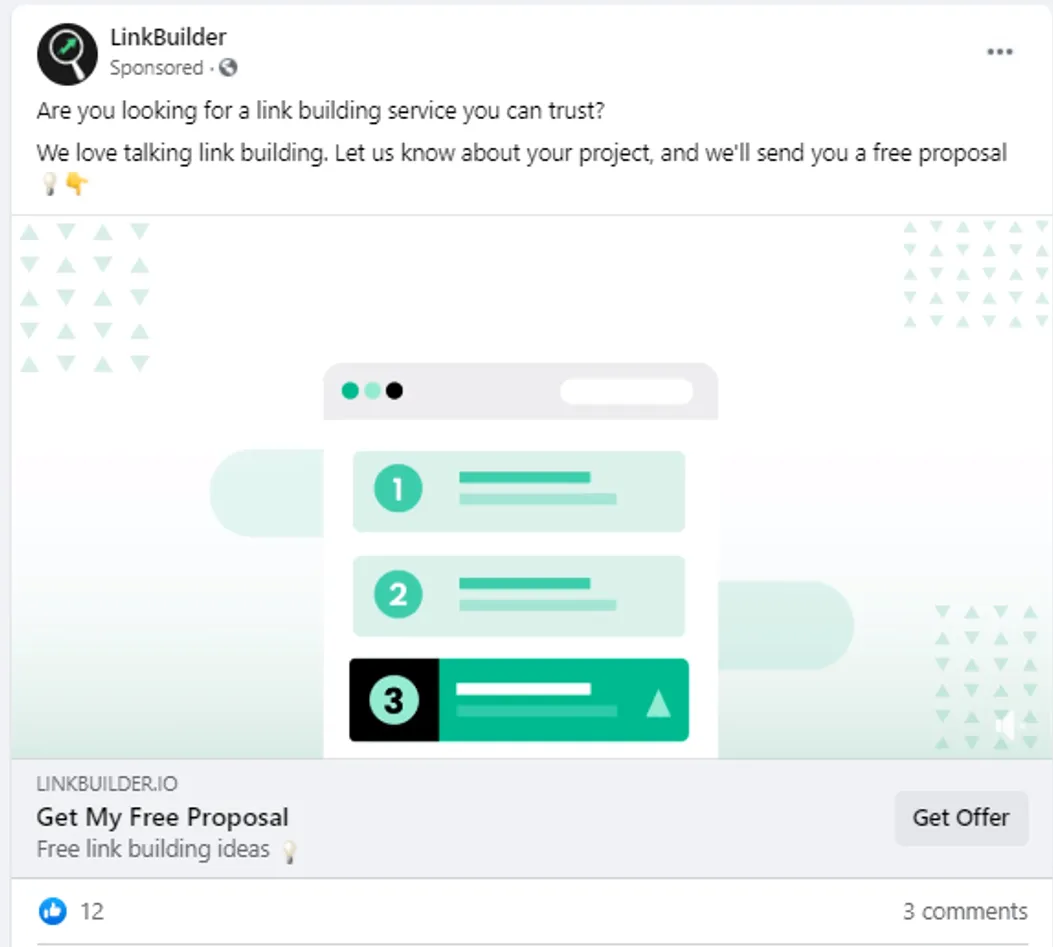
This approach is effective because many of our clients are willing to wait for conversions, while Facebook ads help “plant the seed” for brand awareness in the meantime.
The type of user interaction also plays a crucial role:
If a potential buyer added a product to their cart but didn’t complete the purchase, showing them a PPC ad as soon as possible can help finalize the sale. Sometimes, that small push is all they need to make a decision.
If they only clicked on a top-of-the-funnel blog post or watched an introductory product video, they might not be ready to buy yet. In this case, a different retargeting approach is needed.
Consider Seasonality
The time of year when you launch Facebook ads can make a big difference. Running ads when your target audience has strong purchase intent can boost ROAS, even if higher competition leads to increased CPC.
Many retailers heavily invest in advertising at the end of the year, knowing that consumers are actively shopping for holiday gifts. However, a B2B provider might struggle during this period since yearly budgets are running out, and businesses are winding down operations before the break.
Other seasonal factors also impact sales. For example, the greeting card retailer Thortful is aware of this and strategically runs ads before Mother’s Day and Father’s Day to maximize engagement and conversions.
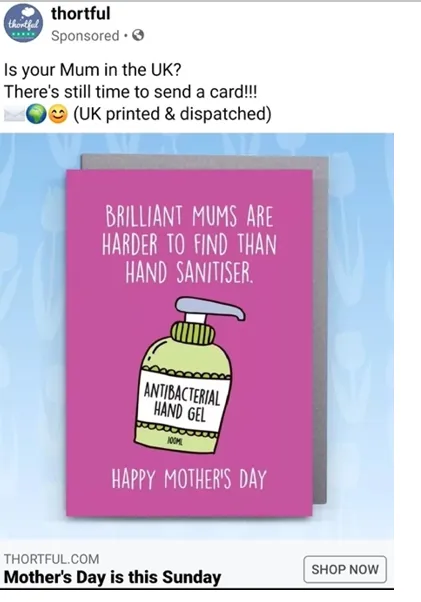
Even if you run ads year-round, you can still adapt your offers based on the season. Promote seasonal sales or take advantage of relevant festivals and holidays.
Think about when customers are most likely to need your product and schedule your ads accordingly.
Monitor External Factors
2020 was not a typical year. Many external factors had a significant impact on PPC costs and the ability to achieve a positive ROAS.
In March 2020, during the COVID-19 crisis, brands cut back on advertising spend, leading to a 15-20% drop in CPC compared to February. Lower ad costs meant that companies that continued running ads had more room for experimentation.
The crisis affected different product categories in different ways, which in turn impacted ad performance.
Sales of loungewear and activewear surged, while
Sales of formal wear declined, as remote workers no longer needed office attire.
COVID-19 was not the only external factor that influenced Facebook PPC. In 2020, ad prices surged during the U.S. presidential elections as well-funded political campaigns flooded Facebook with ads.
How to Adapt to External Factors
Monitor overall sales trends – Is your business experiencing an unexpected sales increase? If so, consider whether external factors are driving this change and create a campaign to leverage the opportunity.
Analyze individual product sales – If a specific product sees a surge in demand, external factors may be at play. Consider launching an ad campaign focused on promoting that product.
Optimizing Facebook Ad Images
When creating pay-per-click (PPC) ads, it can be tempting to focus primarily on technical campaign elements while treating content as secondary. However, content plays a crucial role in the success of your Facebook ads.
The images you use are critical to performance.
Create Facebook ads that align with your overall brand style so that people instantly recognize them as yours.
This is especially important if your target audience includes users who have previously interacted with your content.
Take Chili Piper’s ad as an example. The ad’s colors, font, and logo perfectly match the branding on its landing page. This consistency makes the ad instantly recognizable to people familiar with the brand.
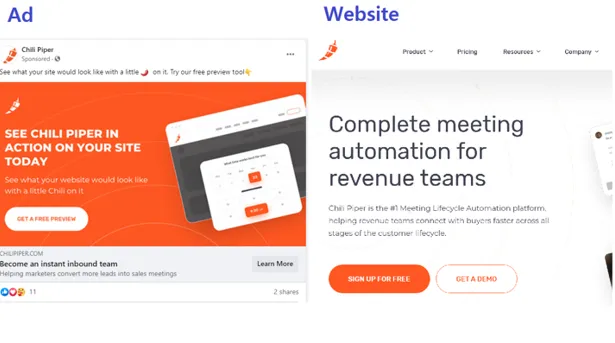
Similarly, if you plan to run a product carousel ad, choose images that showcase your product in the best possible way.
MetrixLab found that optimized images can increase sales by 10%–30%.
Optimize Ad Copy
Writing great ad copy is key to driving conversions. The text, headline, and call-to-action (CTA) all work together to influence ad performance.
One of the best early-stage strategies is to tap into your audience’s dreams or worst-case scenarios. Then, show how your product can help them achieve their goal or avoid the problem.
The Freeletics workout app ad below is a perfect example of dream-based copywriting with the phrase:
“I get in shape in just 15 minutes a day.”
For someone trying to get fit, this is exactly what they want to hear.

This Fiverr ad also performs well. It promises that users of the service can “find freelancers who will take your business to the top of search results.”
It’s a simple statement, but highly appealing to website owners looking to increase traffic.
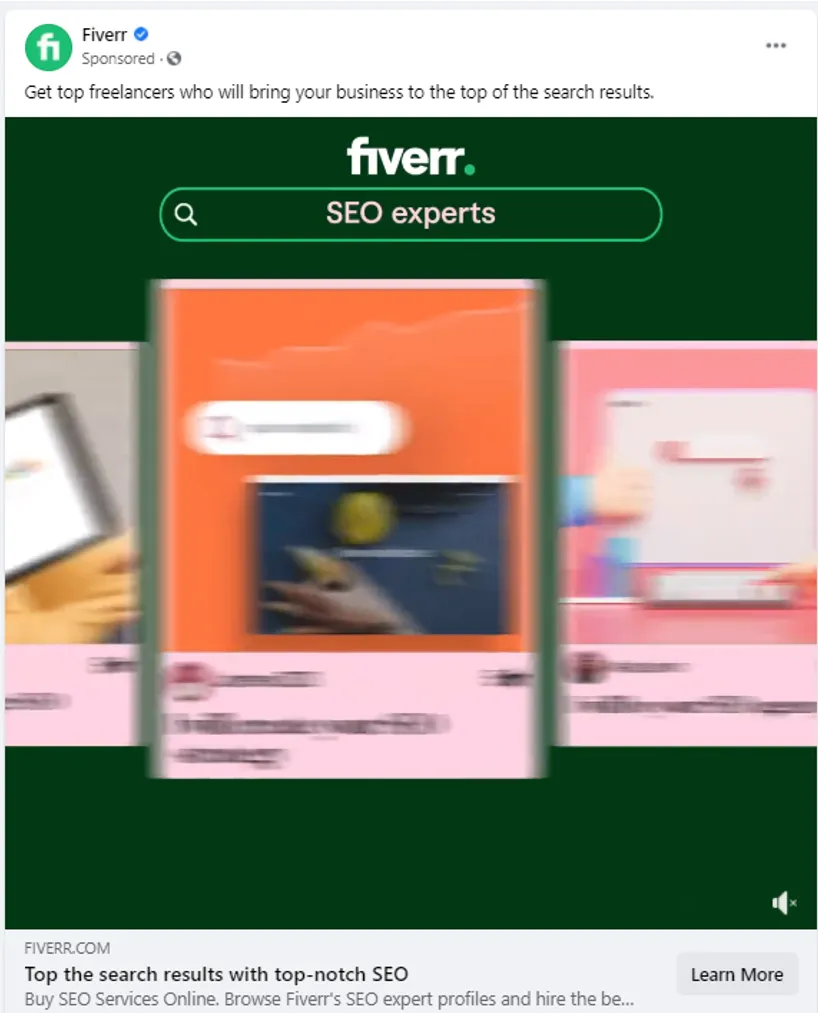
Run PPC A/B Tests to Identify What Works
Optimizing Facebook ads sounds great in theory, but how do you know what actually works? The key is A/B testing to measure ad effectiveness.
Run different ad variations to see which performs better. Start with broad tests, then narrow down.
For example:
Test long-form ad copy vs. a single-sentence ad. Identify which one drives better engagement and use that format.
Experiment with different wording or images to see if conversions improve even further.
The goal is to continuously test and refine your PPC campaign until you find a formula that consistently works.

Key Steps for Effective A/B Testing
Change only one element per test. If you modify multiple factors at once, you won’t know which change led to better results.
Run ads long enough to gather meaningful results. Otherwise, a few isolated conversions could skew your data. Facebook recommends running tests for at least four days.
Use the same audience for all ad variations. This ensures that differences in performance are due to the ad itself, not the audience.
Leverage past test data for future campaigns. Apply insights from previous tests to refine and optimize your next PPC campaigns.
Ensuring a Seamless User Experience
Have you ever clicked on a Facebook ad only to land on a page that says the product is out of stock? This wastes the user’s time and the company’s advertising budget.
Another frustrating experience is clicking on an offer, only to be directed to a generic page where the relevant content is buried.
It’s crucial to send users to a landing page that directly corresponds to the ad they clicked on. To achieve this:
Create dedicated landing pages for each PPC offer.
Ensure the user immediately sees a matching headline, image, or description that confirms they are in the right place.
Deliver on the promise made in the ad.
A great example of this is Freshbooks. Their Facebook ad and landing page use the same image, color scheme, and wording. The offer remains consistent, reinforcing trust and engagement.
Understand Which Offers Resonate with Your Audience
You can target a well-crafted Facebook ad to the perfect audience, but if the offer isn’t compelling, conversions won’t happen.
If your PPC campaign isn’t delivering the desired results, consider experimenting with different offers. Here’s how this approach can work for various types of campaigns.
Lead Generation
Companies looking to generate leads should analyze existing customer data to identify the resources that resonate most with their audience.
Look for:
Blog posts with the highest views
Downloadable resources that consistently attract sign-ups
Either incorporate these assets into your campaign or repurpose them into new types of content to maximize engagement and conversions.
E-Commerce
An e-commerce store can experiment with different products in its ads.
Create ads featuring various bestsellers and analyze which ones drive the most conversions.
Subscription Services
Subscription services can experiment with different ways to promote their product, such as:
Free trials
Money-back guarantees
Discounts on long-term plans
Limited-time offers
No matter what type of campaign you run, always test multiple offers and track their effectiveness. By gathering data on what works best, you can focus on the offers that deliver the highest conversions and ROI.

In this Doodly ad, the offer is highlighted as limited-time only, creating a sense of urgency.
Track the Impact of Your Pay-Per-Click Campaign on Sales
When running a PPC campaign, it’s essential to track how users interact with your business throughout the sales funnel.
Imagine launching an ad campaign with a higher-than-average sign-up rate for a free offer. While this may seem like a good start, if those new leads fail to convert into paying customers, your ad spend is wasted.
It may be more effective to adjust your targeting strategy, focusing on audiences less likely to sign up for a free offer but more likely to make a purchase in the long run.
You can use Facebook Pixel to track leads as they move through your sales funnel. Additionally, by creating dedicated landing pages for each offer, you can attribute sales to specific campaigns and measure their true impact on revenue.
Optimization is the Key to an Effective Facebook PPC Campaign
Monitoring your Facebook ad campaign and making adjustments when necessary is crucial to ensuring maximum returns on your ad spend.
If you’d rather have an expert handle the optimization for you, we can help.
At PPC Genius, we assist ambitious brands in increasing leads, customers, and profits through high-performing PPC campaigns.


